
- Home
- Travel Packages
- Top Destination
-
Travel Attraction
By Category
Top Attraction

- Travel Agents
- Car Rentals
- Hotels

The Copacabana is a world-famous neighborhood located in the southern part of Rio de Janeiro, Brazil. It is known for its beautiful sandy beach, vibrant nightlife, and breathtaking views of the Atlantic Ocean. The neighborhood is also home to upscale hotels, restaurants, and shops, making it a popular destination for tourists from around the world. Water Sports The Copacabana beach is a hub for water sports enthusiasts. Visitors can enjoy activities such as surfing, stand-up paddleboarding, and swimming in the crystal-clear waters. There are also rental shops along the beach where you can rent equipment for various water sports. How To Reach The Copacabana neighborhood is easily accessible by public transportation. Visitors can take a bus or taxi from the city center or use the metro system to reach the area. If you are traveling from the airport, you can take a shuttle bus or taxi to get to Copacabana. Best Time To Visit The best time to visit Copacabana is during the summer months of December to March when the weather is warm and sunny. However, if you prefer fewer crowds, you can also visit during the shoulder seasons of April to June or September to November. Places To Stay Near Copacabana There are plenty of accommodation options near Copacabana ranging from luxury hotels to budget-friendly hostels. Some popular hotels in the area include the Belmond Copacabana Palace, Hotel Atlantico Copacabana, and Windsor Excelsior Hotel. Traveller Tip It is advisable to be cautious with your belongings while visiting Copacabana, as it can be a crowded tourist area. Make sure to keep your valuables safe and avoid carrying large amounts of cash. Things To Carry When visiting Copacabana, make sure to carry essentials such as sunscreen, a hat, sunglasses, a beach towel, and a reusable water bottle. It is also a good idea to carry a small backpack to store your belongings while exploring the area. Tourist Attractions To See In And Around The Copacabana While in Copacabana, make sure to visit the iconic Copacabana Beach, take a stroll along the Avenida Atlântica promenade, and visit the historic Forte de Copacabana. You can also explore nearby attractions such as the Sugarloaf Mountain and the Christ the Redeemer statue. Shopping Copacabana offers a variety of shopping opportunities for visitors. You can shop for souvenirs, beachwear, jewelry, and local handicrafts at the street markets and shops in the area. Some popular shopping spots in Copacabana include the Rio Sul Shopping Center and Galeria River. Nightlife At Copacabana At night, Copacabana transforms into a lively nightlife destination with bars, clubs, and restaurants lining the streets. Visitors can enjoy live music, dance the night away at a samba club, or simply relax with a drink by the beach. Some popular nightlife spots in Copacabana include Bip Bip, Fosfobox, and Bar Bukowski.
Explore More
Barra da Tijuca is a neighborhood located in the western region of Rio de Janeiro, Brazil. Also referred to as Barra, it is known for its stunning beaches, water sports, shopping centers, and vibrant nightlife. The area has seen significant development in recent years, becoming a popular destination for tourists and locals alike. Water Sports Barra da Tijuca is a paradise for water sports enthusiasts. The expansive beach offers opportunities for surfing, stand-up paddleboarding, kayaking, and windsurfing. Visitors can also take boat trips to explore the nearby islands or try their hand at parasailing for a unique view of the coastline. How To Reach Barra da Tijuca is easily accessible by public transportation or taxi from the city center of Rio de Janeiro. The BRT (Bus Rapid Transit) system connects various parts of the neighborhood, making it convenient for visitors to move around. Additionally, there are plenty of taxis available for hire, providing a more direct and comfortable mode of transportation. Best Time To Visit The best time to visit Barra da Tijuca is during the summer months of December to March when the weather is warm and sunny. This is the perfect time to enjoy the beach and water sports activities. However, the neighborhood can get crowded during this time, so visitors looking for a more peaceful experience may prefer to visit during the shoulder seasons of spring or fall. Places To Stay Near Barra da Tijuca There are numerous accommodation options in and around Barra da Tijuca, ranging from luxury resorts to budget-friendly hostels. Some popular hotels in the area include Windsor Marapendi, Grand Hyatt Rio de Janeiro, and Hilton Barra Rio de Janeiro. Visitors can also opt for vacation rentals or Airbnb properties for a more personalized experience. Traveller Tip It is recommended for visitors to stay hydrated and wear sunscreen when spending time outdoors in Barra da Tijuca, especially during the peak summer months. The sun can be quite strong, so protecting your skin and staying cool is essential for a pleasant experience. Things To Carry When visiting Barra da Tijuca, it is important to carry essentials such as a hat, sunglasses, beach towels, and sunscreen to protect yourself from the sun. If you plan on engaging in water sports activities, don't forget to bring swimwear, a rash guard, and water shoes for added comfort and safety. Tourist Attractions To See In And Around Barra da Tijuca Barra da Tijuca has several tourist attractions worth exploring, including the Pedra Bonita hiking trail, Tijuca National Park, and the famous BarraShopping mall. Visitors can also take a day trip to nearby attractions such as the Christ the Redeemer statue, Sugarloaf Mountain, and the historic neighborhoods of Santa Teresa and Lapa. Shopping For those interested in shopping, Barra da Tijuca offers a wide range of options, from high-end boutiques to local markets. BarraShopping is one of the largest shopping centers in Latin America, featuring numerous stores, restaurants, and entertainment facilities. Visitors can shop for fashion, electronics, souvenirs, and more at this iconic mall. Nightlife At Barra da Tijuca Barra da Tijuca comes alive at night with its vibrant nightlife scene. The neighborhood offers a variety of bars, nightclubs, and live music venues where visitors can dance the night away and socialize with locals and other tourists. Some popular spots for nightlife in Barra da Tijuca include All In, Barra Music, and Barril 8000.
Explore More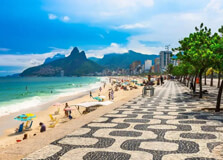
Ipanema is a neighborhood located in the southern region of Rio de Janeiro, Brazil. It is known for its stunning beaches, vibrant culture, and lively atmosphere. The neighborhood is famous for its iconic beach, which stretches for about 2 kilometers and is divided into different sections, each with its own unique charm. Water Sports Ipanema Beach is the perfect destination for water sports enthusiasts. Visitors can enjoy activities such as surfing, stand-up paddleboarding, and beach volleyball. The strong waves and clear blue waters make it an ideal spot for those looking to have some fun in the sun. How To Reach Visitors can easily reach Ipanema by taking a taxi, bus, or metro from various parts of Rio de Janeiro. The neighborhood is well-connected and easily accessible, making it a popular destination for both locals and tourists. Best Time To Visit The best time to visit Ipanema is during the summer months of December to March when the weather is warm and sunny. This is the perfect time to enjoy the beach and outdoor activities. However, visitors should be prepared for crowds during this time of year. Places To Stay Near Ipanema There are plenty of accommodation options near Ipanema Beach, ranging from budget-friendly hostels to luxury hotels. Some popular choices include the Fasano Hotel, Sol Ipanema Hotel, and Mar Ipanema Hotel. Visitors can choose a place to stay based on their budget and preferences. Traveller Tip One important tip for travelers visiting Ipanema is to be cautious of their belongings, especially on the beach. It's recommended to avoid bringing valuables to the beach and to keep an eye on personal items at all times. Additionally, it's a good idea to use sunscreen and stay hydrated while spending time outdoors. Things To Carry When visiting Ipanema, visitors should make sure to pack essentials such as sunscreen, a hat, sunglasses, a beach towel, and comfortable footwear. It's also a good idea to bring a reusable water bottle to stay hydrated while exploring the neighborhood. Tourist Attractions To See In And Around The Ipanema There are several tourist attractions worth visiting in and around Ipanema, including the iconic Christ the Redeemer statue, Sugarloaf Mountain, and the Tijuca National Park. Visitors can also explore the vibrant street art scene in the neighborhood and enjoy local music and dance performances. Shopping Ipanema is known for its trendy boutiques, designer stores, and local markets. Visitors can shop for everything from stylish swimwear and beach accessories to unique souvenirs and handmade crafts. Some popular shopping destinations in the neighborhood include the H. Stern jewelry store, Hippie Fair, and Galeria River. Nightlife At Ipanema When the sun goes down, Ipanema comes alive with a vibrant nightlife scene. Visitors can enjoy live music, dancing, and cocktails at the neighborhood's bars, clubs, and restaurants. Some popular nightlife spots in Ipanema include Bar Astor, Canastra Bar, and Fasano Al Mare.
Explore More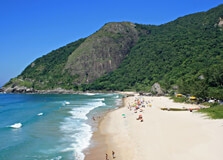
Prainha Beach is a hidden gem located in Rio de Janeiro, Brazil. Nestled between lush green mountains and the sparkling blue waters of the Atlantic Ocean, this secluded beach offers a peaceful retreat from the hustle and bustle of the city. The beach is known for its pristine white sands, clear waters, and stunning natural beauty, making it a popular destination for tourists and locals alike. Water Sports Prainha Beach is a paradise for water sports enthusiasts. Visitors can enjoy activities such as surfing, stand-up paddleboarding, snorkeling, and diving in the crystal-clear waters of the beach. The strong waves make it an ideal spot for surfing, attracting surfers from around the world. If you're looking for adventure and adrenaline, Prainha Beach is the perfect place to indulge in water sports. How To Reach Prainha Beach is located in the Recreio dos Bandeirantes neighborhood of Rio de Janeiro. The beach is easily accessible by car or public transportation. Visitors can take a taxi, ride-sharing service, or bus to reach the beach. If you're driving, there is a parking lot available near the beach for a fee. Best Time To Visit The best time to visit Prainha Beach is during the summer months, from December to March, when the weather is warm and sunny. However, the beach can get crowded during this time, so if you prefer a quieter experience, consider visiting during the shoulder seasons of spring or fall. The weather is pleasant, and the beach is less crowded, allowing you to fully enjoy the beauty of Prainha Beach. Places To Stay Near Prainha Beach There are several accommodation options near Prainha Beach, ranging from budget-friendly hostels to luxury resorts. Visitors can choose to stay in the Recreio dos Bandeirantes neighborhood or in nearby neighborhoods such as Barra da Tijuca or Pontal. Some popular hotels near Prainha Beach include Hotel Atlântico Sul, Promenade Barra First, and Windsor Barra Hotel. Traveller Tip One tip for visitors to Prainha Beach is to arrive early in the morning to secure a good spot on the beach. The beach can get crowded later in the day, especially during the weekends and holidays. Additionally, be sure to bring plenty of sunscreen, as the sun can be strong, and don't forget to stay hydrated by drinking plenty of water throughout the day. Things To Carry When visiting Prainha Beach, be sure to bring essential items such as sunscreen, a hat, sunglasses, a beach towel, swimwear, and a reusable water bottle. Additionally, consider packing snacks, a beach umbrella, and a beach chair for added comfort during your visit. It's also a good idea to bring cash for beach vendors and facilities. Tourist Attractions To See In And Around Prainha Beach While at Prainha Beach, visitors can explore nearby attractions such as Pedra do Pontal, a scenic rock formation offering panoramic views of the beach and ocean. Nature lovers can also visit the Grumari Environmental Protection Area, a pristine natural reserve with hiking trails and wildlife. Additionally, the nearby Prainha Municipal Park is a great spot for picnicking and enjoying the outdoors. Shopping Prainha Beach is not known for its shopping options, as the focus here is on enjoying nature and water sports. However, visitors can find some beach vendors selling snacks, drinks, and souvenirs. For a wider variety of shopping options, consider visiting nearby neighborhoods such as Barra da Tijuca or Pontal, where you can find shopping malls and local markets. Nightlife At Prainha Beach Prainha Beach is a tranquil destination perfect for relaxing and unwinding by the sea. While there are no nightclubs or bars directly on the beach, visitors can enjoy a peaceful evening watching the sunset over the ocean or strolling along the shore under the moonlight. For those looking for nightlife options, nearby neighborhoods such as Barra da Tijuca offer a variety of bars, restaurants, and clubs for a lively night out.
Explore More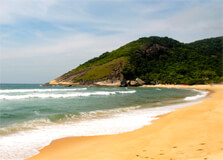
The Grumari Beach is a hidden gem located in Rio de Janeiro, Brazil. It is known for its pristine white sand beach, clear blue waters, and untouched natural beauty. The beach is surrounded by lush green hills, creating a picturesque backdrop for visitors to enjoy. Water Sports Grumari Beach is a popular destination for water sports enthusiasts. Visitors can partake in activities such as surfing, stand-up paddleboarding, and kite surfing. The strong waves and steady winds make it an ideal spot for these activities. How To Reach Grumari Beach is located in the western part of Rio de Janeiro. It can be easily reached by car or public transportation. Visitors can take a bus to Recreio dos Bandeirantes and then a taxi to the beach. It is also possible to hire a private car or join a tour to get to the beach. Best Time To Visit The best time to visit Grumari Beach is during the summer months (December to March) when the weather is warm and the water is perfect for swimming. However, the beach can get crowded during this time, so visitors looking for a more peaceful experience may want to visit during the off-peak season. Places To Stay Near Grumari Beach There are several accommodation options near Grumari Beach, ranging from budget-friendly hostels to luxury resorts. Some popular choices include the Grumari Hostel, Hotel Pousada Recreio Dos Bandeirantes, and Casa da Praia Guesthouse. Traveller Tip One important tip for visitors to Grumari Beach is to bring plenty of sunscreen and water. The sun can be strong, so it is essential to stay hydrated and protected from UV rays. Additionally, visitors should be mindful of their belongings and avoid leaving valuables unattended on the beach. Things To Carry Visitors to Grumari Beach should consider carrying essentials such as sunscreen, a hat, sunglasses, a beach towel, and a reusable water bottle. It is also a good idea to bring a camera to capture the stunning natural beauty of the beach. Tourist Attractions To See In And Around The Grumari Beach There are several tourist attractions to explore in the vicinity of Grumari Beach. Some popular options include hiking in the nearby Tijuca National Park, visiting the Pedra do Pontal lookout point, and exploring the rock formations at Prainha Beach. Shopping Grumari Beach is not known for its shopping opportunities, but visitors can find some local vendors selling souvenirs such as handmade jewelry, clothing, and accessories. Additionally, there are markets and shops in the nearby neighborhoods where visitors can purchase gifts and mementos. Nightlife At Grumari Beach While Grumari Beach is not known for its nightlife, visitors can find some beach bars and restaurants that stay open late. These establishments often host live music events, beach parties, and bonfires where visitors can relax and socialize with locals and other tourists.
Explore More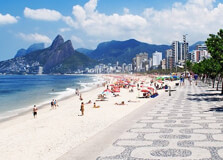
The Ipanema Beach is one of the most famous and vibrant beaches in Rio de Janeiro, Brazil. Known for its stunning views, white sandy shores, and clear blue waters, Ipanema Beach is a popular destination for both locals and tourists alike. The beach stretches for approximately two miles along the South Atlantic Ocean, offering plenty of space for sunbathing, swimming, and relaxing. Water Sports Visitors to Ipanema Beach can enjoy a variety of water sports, including surfing, stand-up paddleboarding, and beach volleyball. There are rental shops along the beach where you can easily hire equipment for these activities. The waves at Ipanema Beach are perfect for surfing, making it a favorite spot for surfers of all levels. How To Reach Ipanema Beach is easily accessible by public transportation, taxi, or car. If you're coming from the city center, you can take a bus or subway to Ipanema and then walk to the beach. Taxis are also readily available throughout the city. If you prefer to drive, there are parking lots near the beach where you can park your vehicle. Best Time To Visit The best time to visit Ipanema Beach is during the summer months, from December to March, when the weather is warm and sunny. This is also when the beach is busiest, with both locals and tourists flocking to the shore to soak up the sun and enjoy the vibrant atmosphere. If you prefer fewer crowds, consider visiting during the shoulder seasons of spring or fall. Places To Stay Near Ipanema Beach There are plenty of accommodation options near Ipanema Beach, ranging from luxury hotels to budget-friendly hostels. Some popular hotels near the beach include the Fasano Rio de Janeiro, Hotel Arpoador, and Hotel Sol Ipanema. Staying in this area will not only give you easy access to the beach but also to the many restaurants, bars, and shops in the neighborhood. Traveler Tip One tip for visiting Ipanema Beach is to arrive early in the morning to secure a good spot on the sand. The beach can get crowded, especially on weekends and holidays, so arriving early will ensure you have a prime location to relax and enjoy the sun. Additionally, be sure to wear sunscreen and stay hydrated, as the sun in Rio de Janeiro can be intense. Things To Carry When visiting Ipanema Beach, it's essential to pack a few key items to ensure a comfortable day at the beach. Be sure to bring sunscreen, sunglasses, a hat, and a beach towel. If you plan on swimming or participating in water sports, don't forget to pack a swimsuit, towel, and any necessary equipment. A reusable water bottle and snacks are also recommended to stay hydrated and energized throughout the day. Tourist Attractions To See In And Around Ipanema Beach While Ipanema Beach itself is a popular attraction, there are several other tourist spots worth visiting in the area. Nearby attractions include the famous Copacabana Beach, the iconic Sugarloaf Mountain, and the lush Tijuca National Park. You can also explore the charming neighborhoods of Ipanema and Leblon, known for their trendy shops, restaurants, and nightlife. Shopping Ipanema Beach is surrounded by a variety of shops and boutiques where you can find everything from souvenirs and beachwear to designer clothing and accessories. The Hippie Fair, held on Sundays near the beach, is a great place to shop for unique handicrafts and artworks. For upscale shopping, head to Rua Garcia D'Ávila, known for its luxury boutiques and designer stores. Nightlife At Ipanema Beach As the sun sets over Ipanema Beach, the vibrant nightlife scene comes alive. There are plenty of bars, restaurants, and clubs along the beachfront where you can enjoy a cocktail, live music, or a night of dancing. The beach is also a popular spot for beach parties and events, especially during the summer months. Whether you're looking for a relaxing evening with a sunset view or a lively night out, Ipanema Beach has something for everyone.
Explore More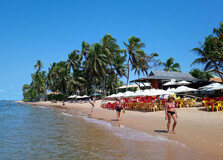
Praia do Forte is one of the most charming and well-preserved beach destinations in the state of Bahia, Brazil. Located just 80 kilometers north of Salvador, it is a former fishing village that has grown into a popular eco-tourism hub. The area is famous for its beautiful beaches, coral reefs, Atlantic Forest, and cultural heritage. It is also home to the renowned Projeto Tamar, a sea turtle conservation project, and attracts visitors interested in nature, marine life, and sustainability. How to Reach Praia do Forte, Bahia Reaching Praia do Forte is easy and convenient, especially from Salvador. By Car: The most common way to get to Praia do Forte is by car. From Salvador, take the BA-099 highway (Linha Verde), which is well-maintained and signposted. The drive takes approximately 1.5 to 2 hours. By Shuttle or Bus: Several shuttle services operate between Salvador and Praia do Forte, especially from hotels or the airport. Alternatively, regular buses run from Salvador’s Rodoviária (bus station) to Praia do Forte and nearby towns. By Taxi or App Rides: Taxis and rideshare apps like Uber are available from Salvador, including from the airport. This option is more expensive but offers door-to-door service. Once in Praia do Forte, the village is compact and walkable, with most attractions located close to each other. Weather in Praia do Forte, Bahia Praia do Forte has a warm tropical climate throughout the year, with average temperatures ranging from 24°C to 30°C (75°F to 86°F). The region experiences two main seasons: Dry Season (September to February): This is the best time to visit. The weather is sunny, hot, and ideal for swimming, snorkeling, and walking through nature trails. Wet Season (March to August): Rainfall is more frequent but typically comes in short bursts. The lush greenery during this season makes it a good time for eco-tourism and bird watching. Timing and Best Season to Visit The high season in Praia do Forte coincides with Brazilian summer, from December to February, including holidays like Christmas, New Year, and Carnival. It’s a festive time, but the village can be busy and accommodations more expensive. The shoulder months of September to November and March to May are perfect for those looking to avoid crowds while enjoying good weather and lower prices. Why Famous for Praia do Forte, Bahia? Praia do Forte is renowned for its combination of natural beauty, biodiversity, environmental conservation, and cultural charm. It’s particularly known for: Projeto Tamar: A national project dedicated to the protection of sea turtles. Visitors can observe turtles and learn about marine conservation. Stunning Beaches: Wide stretches of golden sand, palm trees, natural pools, and calm waters make it a beach lover’s paradise. Sustainable Tourism: Praia do Forte is a model for eco-friendly tourism in Brazil, with strict guidelines to preserve its natural and cultural resources. Entry and Visit Details about Praia do Forte, Bahia Entry to Praia do Forte is free. However, some attractions within the village, such as the Tamar Project and the Garcia D'Ávila Castle ruins, have a small entrance fee. The village is very tourist-friendly, offering a wide range of accommodations, from simple guesthouses to luxury eco-resorts. Restaurants, souvenir shops, and guided tours are readily available. Credit cards are widely accepted, and there are ATMs available. History and Architecture Praia do Forte has historical significance dating back to the 16th century. The most notable historical structure is the Garcia D’Ávila Castle (Castelo Garcia D’Ávila), built in 1551. It is the only medieval-style castle in the Americas and once served as the seat of one of the largest landowners in colonial Brazil. The village maintains its traditional architecture with colorful colonial-style houses, cobblestone streets, and a strong influence of Afro-Brazilian culture. The preservation of this architectural identity adds to its rustic and authentic charm. Things to Do in Praia do Forte, Bahia Visit Projeto Tamar: Learn about sea turtle conservation, observe hatchlings, and interact with educational exhibits. Explore the Beaches: Relax at natural pool beaches like Papa-Gente’s Pool, Praia do Lord, and Praia do Porto. Garcia D’Ávila Castle: Visit the historic castle and enjoy panoramic views of the Atlantic Forest and coast. Whale Watching: From July to October, humpback whales can be seen off the coast on guided tours. Shopping and Dining: Browse local shops for crafts, swimwear, and organic products. Enjoy Bahian cuisine, especially moqueca (fish stew) and acarajé (fried bean patties). Eco Trails: Hike or bike through the Sapiranga Reserve, a protected Atlantic Forest area with waterfalls and native wildlife. Facts and Tips about Praia do Forte, Bahia Interesting Facts: The Tamar Project in Praia do Forte was one of the first in Brazil and is now a national symbol for marine conservation. The area is part of the Coconut Coast (Costa dos Coqueiros), known for its palm-lined beaches and biodiversity. Garcia D’Ávila was one of the wealthiest men in the Americas during the colonial era, owning vast lands and enslaved people. Travel Tips: Wear light clothing, sunscreen, and hats — the sun is strong, especially in summer. Bring mosquito repellent for evening strolls and nature trails. Plan visits to the Tamar Project in the late afternoon when turtle hatchlings are sometimes released into the sea. Weekdays are less crowded, offering a more peaceful experience at major sites. If you visit during whale season, book tours in advance as they are popular and weather-dependent. Praia do Forte is a perfect blend of ecological sensitivity, cultural richness, and coastal beauty. Whether you're strolling through its cozy village, watching turtles return to the sea, or exploring its historical castle, this destination offers a unique and fulfilling experience for all types of travelers.
Explore More